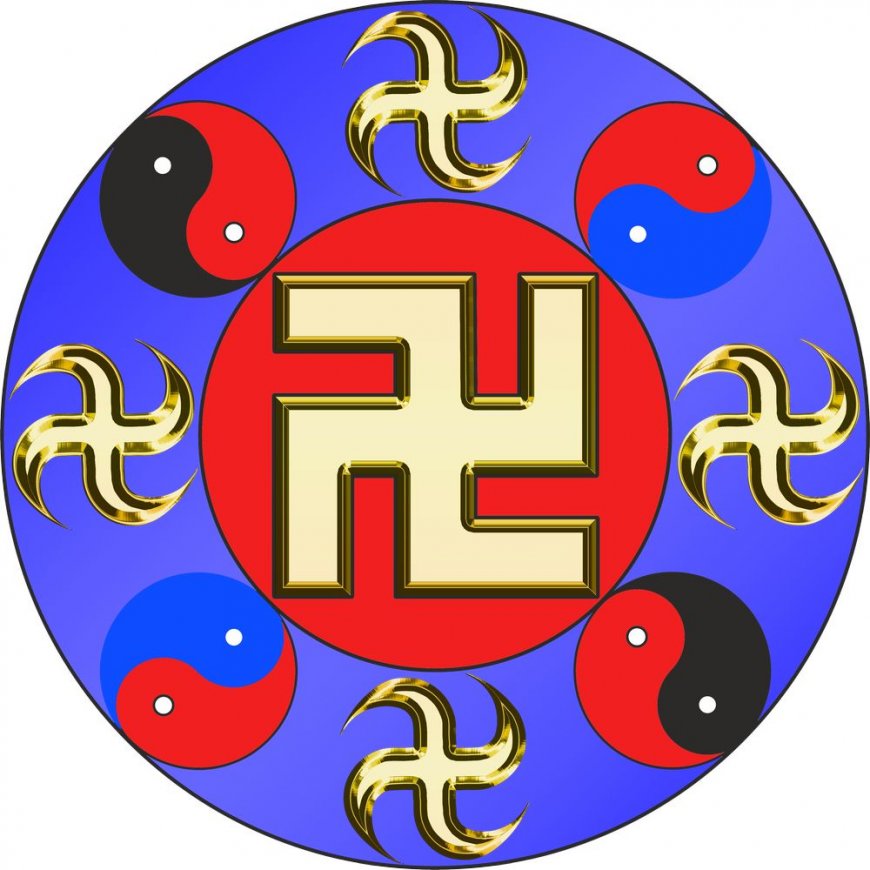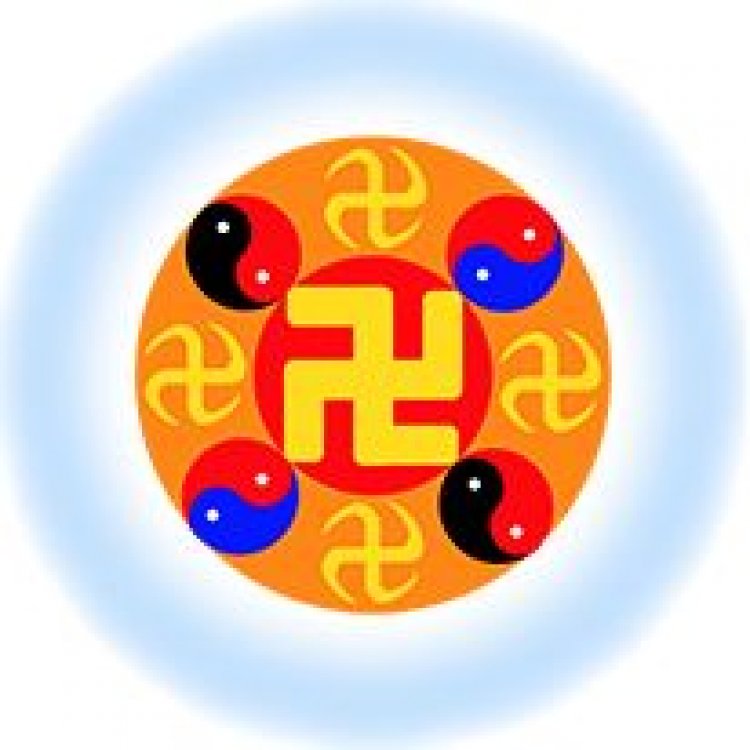The Falun Emblem
The symbol of our Falun Dafa is Falun. Those with supernormal abilities can see that this Falun is rotating. The same is true for our small Falun badges, which are also rotating.

.
![]()
.
The symbol of our Falun Dafa is Falun. Those with supernormal abilities can see that this Falun is rotating. The same is true for our small Falun badges, which are also rotating. Our cultivation practice is guided by Zhen-Shan-Ren, the characteristic of the universe, and by the principles of the cosmos’ evolution. Therefore, what we cultivate is quite immense. In a sense, this Falun emblem is a miniature of the universe. The Buddha School conceptualizes the universe as a world of ten directions with four faces and eight sides. Perhaps some people can see a vertical energy column above and below Falun. With its top and bottom, Falun exactly makes up the ten-directional world and constitutes this universe. It represents the Buddha School’s summary of the universe.
.
This universe, of course, conists of numerous galaxies including our Milky Way. The whole universe is in motion, and so are all galaxies within it. Therefore, the Taiji symbols and the small 卍 symbols in the emblem are also rotating. The entire Falun is rotating, and the large 卍 symbol in the center is rotating as well. In a sense, it symbolizes our Milky Way. Because we are of the Buddha School, the center retains the symbol of the Buddha School; this is how its surface looks. All different substances have their forms of existence in those other dimensions where they have very substantial and very complex processes of evolution and forms of existence. This Falun emblem is the miniature of the universe. It also has its own form of existence and process of evolution in all other dimensions, so I call it a world.
.
When Falun rotates clockwise, it can automatically absorb energy from the universe. Rotating counter-clockwise, it can give off energy. Inward (clockwise) rotation offers self-salvation while outward (counter-clockwise) rotation offers salvation to others—this is a feature of our practice. Some people have asked: "Since we’re of the Buddha School, why is there also Taiji? Doesn’t Taiji belong to the Tao School?" It is because what we cultivate is very immense, which is the same as cultivating the entire universe. Then think about it, everyone: This universe consists of two major schools, the Buddha School and the Tao School. With either of them excluded, it will not constitute a complete universe, and neither can it be called a complete universe. Consequently, we have included things from the Tao School. Also, some people have said that in addition to the Tao School, there are also Christianity, Confucianism, other religions, etc. Let me tell you that after its cultivation reaches a very high level, Confucianism belongs to the Tao School; when many Western religious cultivation practices reach high levels, they are classified as belonging to the same system as ours, the Buddha School. There are only two such major schools.
.
Then why do two of the Taiji patterns have red at the top and blue at the bottom, and the other two Taiji patterns have red at the top and black at the bottom? What we generally understand is that Taiji is made of the two substances of black and white, the qi of yin and yang. That notion comes from a very low level, as Taiji has different manifestations in different dimensions. At the highest level, its colors manifest in this way. The Tao that we commonly understand has this red at the top and this black at the bottom. For instance, some of our practitioners’ Celestial Eye are open, and they have discovered that the red they see with their naked eyes is green in the adjacent dimension. The golden color is seen as purple in another dimension, as it has this inversion. In other words, colors change from dimension to dimension. The Taiji with the red at the top and the blue at the bottom belongs to the Great Primordial-Tao School, which includes the cultivation practices from the Qimen School. The four smaller 卍 symbols are from the Buddha School. They are the same as the one in the middle, which is also from the Buddha School. The Falun in these colors is relatively bright, and we use it as the symbol of Falun Dafa.
.
The Falun that we see through the Celestial Eye is not necessarily in these colors, because its background color can change, although its pattern does not change. When the Falun that I have installed in your lower abdominal area rotates, your Celestial Eye may see it as red, purple, green, or perhaps colorless. Its background color keeps changing in the order of red, orange, yellow, green, sky-blue, blue, and purple. As a result, what you see may be different colors, but the srivatsa1 symbols or the Taiji’s colors and pattern within it will remain the same. We find that this background color looks relatively good, so we have adopted it. Those with supernormal abilities can see a lot of things beyond this dimension.
.
Some people say: "This symbol 卍 looks like Hitler’s stuff." Let me tell you that this symbol itself does not connote any concepts of class. Some people say: "If its corner tilts to this side, it’ll be Hitler’s thing." It is not so, because it rotates both ways. Our human society began to know this symbol widely twenty-five hundred years ago in Sakyamuni’s time. It has only been several decades since Hitler’s time during World War II. He appropriated it, but the color he used was different from ours. It was black and pointing upwards, and was used in the upright position. I will only address so much regarding this Falun, though I have only mentioned its superficial form.
.
Then what does this srivatsa 卍 symbolize in our Buddha School? Some people say that it stands for good fortune, which is an interpretation of everyday people. Let me tell you that 卍 signifies a Buddha’s level. It only exists at the Buddha level. A Bodhisattva or an Arhat does not have it. But senior Bodhisattvas, the Four Senior Bodhisattvas, have it. We have found that these Senior Bodhisattvas have far surpassed the level of ordinary Buddhas, and they are even higher than a Tathagata. Beyond the level of Tathagata, there are numerous Buddhas. A Tathagata has only one 卍 symbol. Those who have reached beyond the level of Tathagata will have more 卍 symbols. A Buddha whose level is twice as high as a Tathagata has two 卍 symbols. For those who are still higher, they have three, four, five srivatsas, and so on. Some have so many srivatsas that they are all over their bodies, including on their heads, shoulders, and knees. When there are too many of them, they will even appear on their palms, fingers, foot arches, toes, etc. As one’s level continually increases, one will have more and more 卍 symbols. Therefore, the 卍 symbol represents a Buddha’s status. The higher a Buddha’s status, the more 卍 symbols a Buddha has.
.
(Cit. Li Hongzhi, Zhuan Falun, Lecture five: The Falun Emblem)
.
.
.

.
.
.













